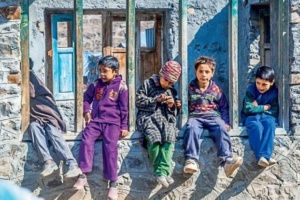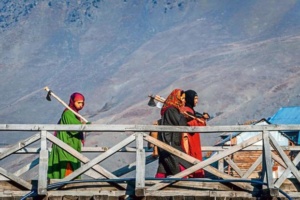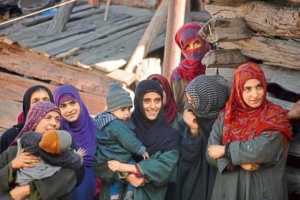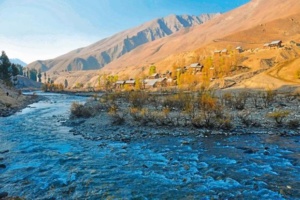For the next four months or so, Gurez Valley in Jammu & Kashmir will be landlocked as the Razdan Pass gets snowed in. Life come to a standstill and there’s little to do but sit indoors by the bukhari. And pray, that the border, which lies just across the mountains, remains as quiet as their surroundings.

First published:
https://www.livemint.com/Leisure/P2rCfGis9AUafqQBwTkIdM/Into-the-Gurez-Valley.html
Into the Gurez Valley
Once the gateway to Central Asia, Gurez Valley in a forgotten corner of Kashmir is still home to the Dard people who live on the fence of modernity
Ghulam Hasan, 76, standing behind a wall of curious onlookers, finally summons the courage to step up with a few questions of his own. It’s been many years since he’s seen so many strange faces at his home in Chakwali—the last village in the Gurez valley, a tehsil in Jammu and Kashmir, at the northern tip of India, and just a short distance from the Line of Control. He shuffles amid the crowd, keenly observing faces and baggage alike, asks a few questions about where we have come from, and returns to his perch in the shade, satisfied with the answers.
It takes a simple hello to get him chatting, and, in the next few minutes, he begins reflecting on an era when visitors frequented these parts.
“There were so many things to see, so many stories to hear. Everyone would be out of their homes, watching the entourage of caravans pass by—some familiar faces, others visiting for the first time,” he says.
Hasan speaks of a time when trade flourished on the Silk Route and Gurez was considered the gateway to Central Asia. There was a sense of excitement each time a caravan made its way through the many villages en route. They brought essential goods from across the high mountains and, more importantly, news from distant lands, helping break the monotony of a secluded existence in the midst of nowhere.
Hasan grew up on a regular dose of such stories, narrated by his elders. For instance, the valley’s renowned potatoes would be taken to Skardu on a day’s march from Chorwan, a short distance from Dawar—the headquarters of Gurez. There, after a quick barter, traders would return with mules laden with apricots and apples. It was just one of the many exchanges that took place in this roving marketplace spread over a hundred miles. Gurez became a hub and a vital link between towns such as Kashgar and Gilgit in the north and Srinagar and Kargil in the south.
All that changed when India and Pakistan were handed their identities in 1947. The trade routes were sealed; the goods stopped coming in, as did the news. The people of Gurez were gradually pushed into a life of self-sustenance, isolation, and, to a certain extent, oblivion, tucked away in a corner of India that they are unfamiliar with.

***
What took me to Gurez was a simple call by Anil Gupta—fondly known as “professor” and founder president of Sristi, an Ahmedabad-based organization that works on grass-roots innovations—who wanted to set up a library at the Government Higher Secondary School in Badugam village. There is no greater joy for a bibliophile than to infect others with the same passion. Then, to do it for people in a remote land that has been afflicted by conflict and despondency was reason enough to gather around thousand books (mostly English, obtained through collection drives) and lug it over a thousand miles to them.
Located in the north-west corner of Kashmir, Gurez lies just 130km from the capital, Srinagar; the stark difference in lifestyles, though, is both enticing and appalling. Once you’re past Bandipora, the road climbs to the Razdan Pass (3,500m), before descending to a land that can best be described as inhabited wilderness. This sole link with the rest of the state gets snowed in from the end of November to April-May, cutting off the region for close to five months of the year. At the opposite end, and across the mountains, lies the same land that was once frequented by the people of Gurez and is today controlled by Pakistan.

This valley is home to the Dards or Dard Shins, who belonged to a region called Dardistan that today straddles India, Pakistan and Afghanistan. A few have stories of family members who were stranded across the mountains once the borders were drawn. There was little to do but start life afresh in a new land. What bound them was the comfort of the Shina language that is spoken in these parts. Some have never been seen since, while those with money have had the opportunity to reunite with their separated relatives. Though this isolation has been a bane, it has preserved the culture of a tribe which traces its ancestry all the way back to the fourth century BC.
In his paper Dards, Dardistan And Dardic, Professor John Mock writes, “In a well-known and much repeated story, Herodotus mentions a war-like people on the frontier of India, near to whom are found gold-digging ants. Herodotus provides the name Dadikai for one of the groups living on India’s frontier, which was then the seventh satrapy of the Achaemenian empire…Alexander, whose travels provide much of the data for classical geography of India, apparently did not meet any Dard people, but he did go to a place called Daedala.”
Not much has changed over the centuries in the daily routine of the Dards, who’ve built their homes in the valleys and on the slopes of Gurez and the neighbouring Tulail valley. Most farm vegetables such as potatoes and peas, and herd livestock for a living. A few tend to the needs of the Indian Army, ferrying supplies on their mules to posts high up in the mountains. The soldiers outnumber the locals, as is the case in most of Kashmir. Though shelling and infiltration have been sporadic in these parts of late, the army’s suffering isn’t very different from that of the Dards. Solitude and cold can break the strongest of people.

***
In his 1895 book, The Valley Of Kashmir, Walter R. Lawrence writes: “Many of the Margs are visited every year by Europeans, and Gulmarg, Sonamarg, and Nagmarg are charming places for a summer holiday. Perhaps Pahlgam, the village of the shepherd which stands at the head of the Liddar valley with its healthy forest of pines, and Gurais which lies at a distance of 35 miles from Bandipura, the port of the Wular lake, will before long rival in popularity the other Margs.”
Unlike Pahalgam, Gurez has survived the onslaught of mass tourism until now due to its proximity to the border, despite being promised Rs 28 crore in July 2007 for upgrading the infrastructure. A few changes though are evident. The Kishanganga hydroelectric project can solve the region’s electricity woes. Though a fraction of it is meant for Gurez, smaller projects upstream are being proposed.
Permits were done away with a few years ago. But most outsiders here are either army men, or backpackers who venture out when the snow thaws off the mountains in cascades. As more follow in the years to come, sustainable growth will be key to protect the home of the hospitable Dards.